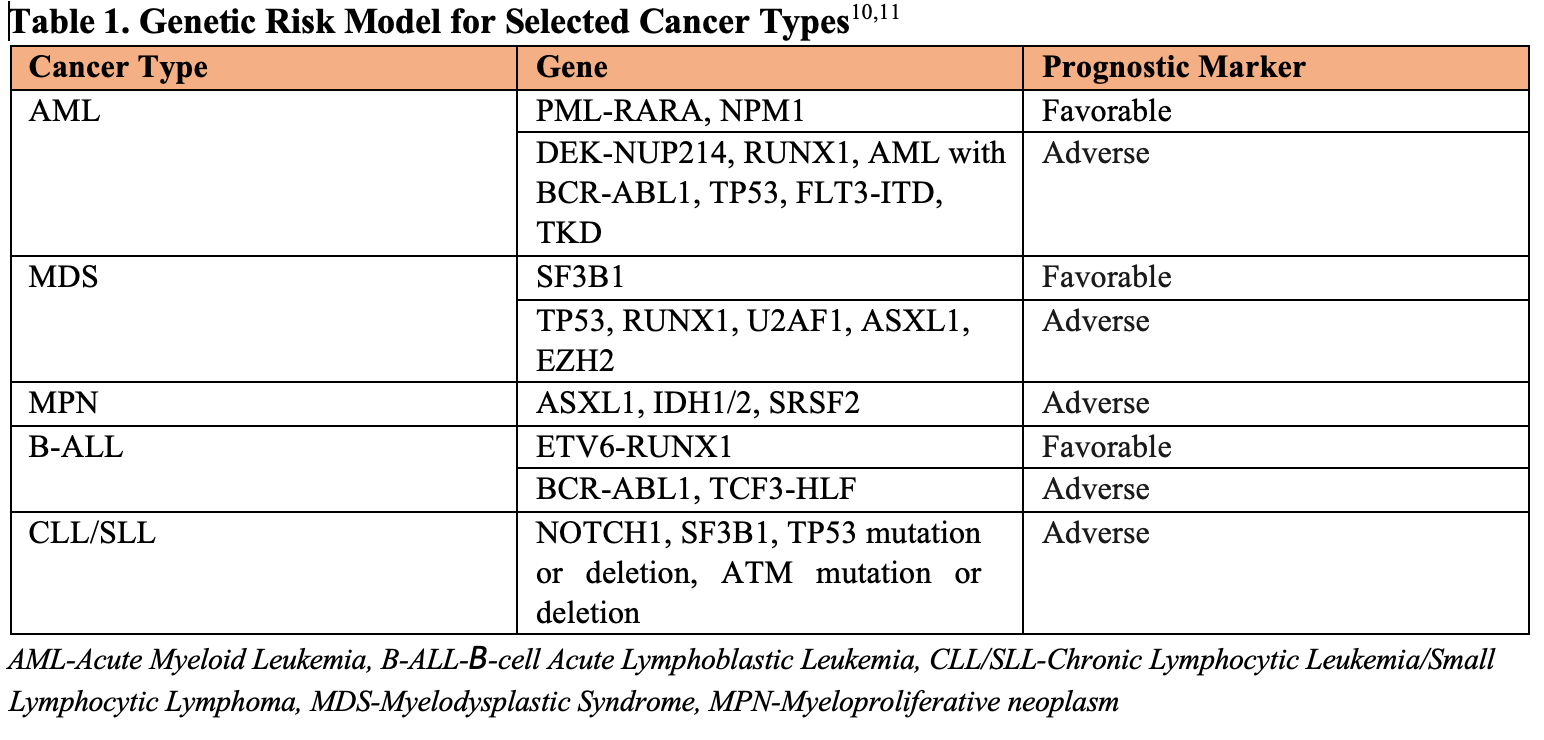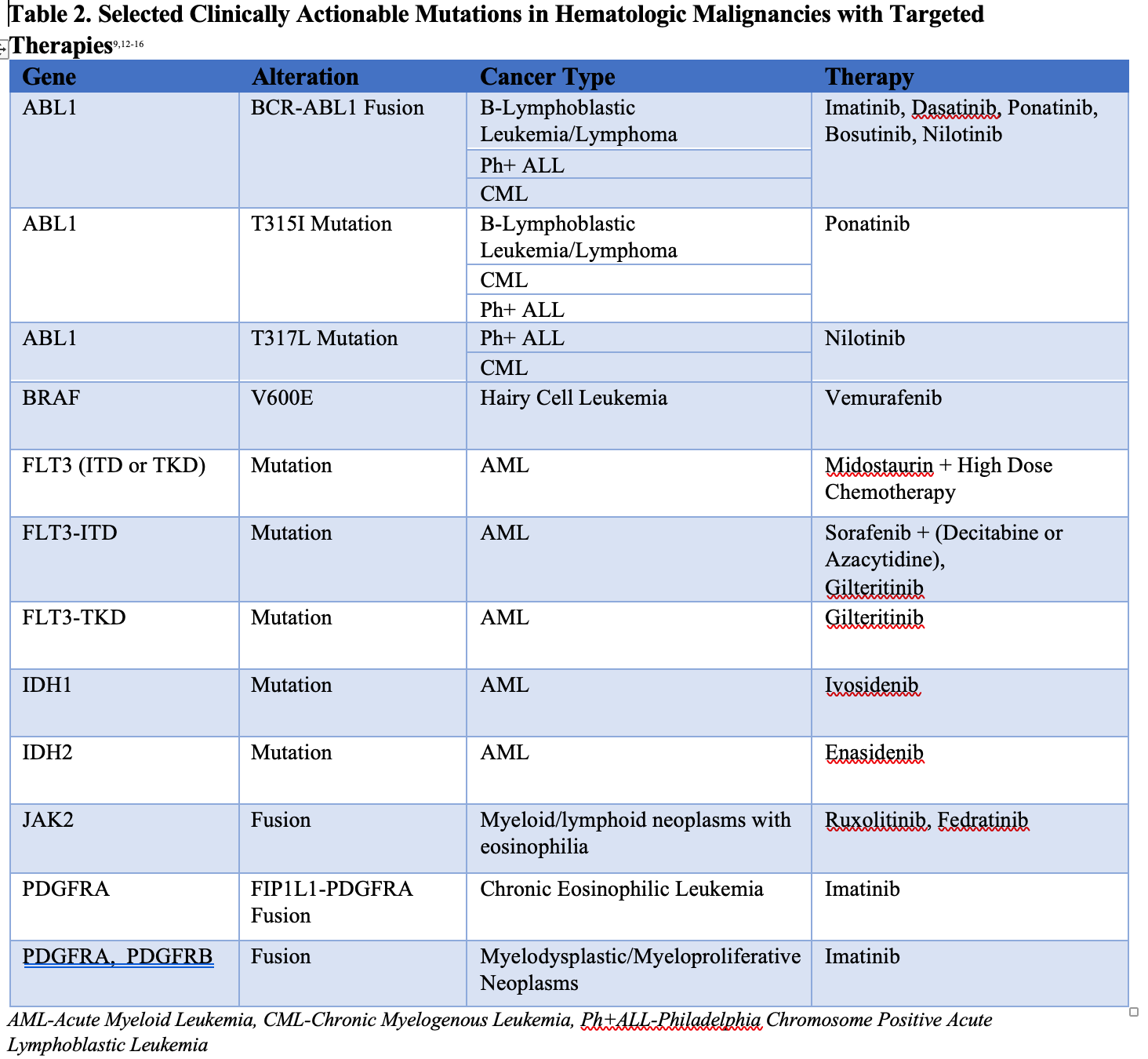Article
Actionable Mutations in Hematologic Malignancies
Author(s):
The use of high throughput technologies has revolutionized the understanding of the cancer genome.
Precision oncology has ushered in a new era in cancer diseases. The use of high throughput technologies has revolutionized the understanding of the cancer genome.1 In hematological malignancies, the application of these genomic studies have led to diagnosis, accurate prognostic stratification,2-4 and tailored treatment strategies to precisely target the molecular alteration underlying the disease.5
Genetic techniques frequently used in hematological malignancies include:
- Conventional cytogenetics (Karotyping)
- Fluorescent in-situ hybridization (FISH)
- Polymerase chain reaction (PCR)
- Next generation sequencing (NGS)
Conventional cytogenetics is a technique used to detect chromosomal aberrations and is used for various leukemias, most prominently to diagnose chronic myelogenous leukemia (CML), by detecting cytogenetic abnormality, t(9,22).6
FISH is a molecular cytogenetic technique performed on cells with low in vitro mitotic index, such as in indolent lymphoid and plasma cell malignancies, in which conventional karyotyping has limitations.6 PCR techniques involve amplification of a desired segment of DNA by using primers, nucleotides and enzymes, such as reverse transcriptase and DNA polymerases, to study various mutations.
Both FISH and PCR can be used to detect BCR-ABL gene rearrangement to diagnose CML. NGS is a genomic profiling technology based on high throughput DNA and RNA parallel sequencing technique and allows thousands of genomes to be studied for molecular changes and actionable mutations in a short time.6,7 The results of genetic tests can show whether a patient has a pathogenic variant, which is an increased risk to develop cancer, or a variant of uncertain significance (VUS), in which the association with cancer risk is unclear.
An alteration can have actionability, which has been broadly defined to mean having potential clinical utility.8 Mutations may be actionable if it:
- Alters prognosis (for example, TP53 mutations confer worse prognosis in leukemia and may lead to consideration of transplantation).
- Predicts therapy sensitivity/resistance (for example, PDGFRA T674I and D842V mutations are resistant to imatinib (Gleevec) in myeloid/lymphoid neoplasms with eosinophilia and tyrosine kinase fusion genes.8,9
- Is targetable with an available anticancer treatment or is the target of developing novel therapeutics.
Table 1 shows genetic risk model encompassing selected gene mutations with their associated prognosis, whereas Table 2 summarizes known actionable mutations and their matched anticancer therapies.


As genomic testing becomes more widely available, molecular-guided therapy remains pivotal in the diagnosis, risk stratification, and treatment choice in hematological malignancies. Integration of cancer genomic data into electronic health records will help pharmacists have a stronger understanding of precision oncology, which is surmount in delivering optimal care for cancer patients.
REFERENCES
1. Yasuda T, Sanada M, Nishijima D, et al. Clinical utility of target capture-based panel sequencing in hematological malignancies: A multicenter feasibility study. Cancer Sci. 2020;111(9):33673378. doi:10.1111/cas.14552
2. Harris MH, DuBois SG, Glade Bender JL, et al. Multicenter Feasibility Study of Tumor Molecular Profiling to Inform Therapeutic Decisions in Advanced Pediatric Solid Tumors: The Individualized Cancer Therapy (iCat) Study. JAMA Oncol. 2016;2(5):608-615. doi:10.1001/jamaoncol.2015.5689
3. Mody RJ, Wu YM, Lonigro RJ, et al. Integrative Clinical Sequencing in the Management of Refractory or Relapsed Cancer in Youth. JAMA. 2015;314(9):913-925. doi:10.1001/jama.2015.10080
4. Sunami K, Ichikawa H, Kubo T, et al. Feasibility and utility of a panel testing for 114 cancerassociated genes in a clinical setting: A hospital-based study. Cancer Sci. 2019;110(4):14801490. doi:10.1111/cas.13969
5. AJMC Perspectives. How Advances in Precision Oncology Are Shaping a New Diagnostic and Treatment Frontier. Am J Manag Care. Published December 2019. Accessed May 15, 2021. https://www.ajmc.com/view/howadvances-in-precision-oncology-new-diagnostic-and-treatment-frontier
6. Prakash G, Kaur A, Malhotra P, et al. Current Role of Genetics in Hematologic Malignancies. Indian J Hematol Blood Transfus. 2016;32(1):18-31. doi:10.1007/s12288-015-0584-4
7. Allegretti M, Fabi A, Buglioni S, et al. Tearing down the walls: FDA approves next generation sequencing (NGS) assays for actionable cancer genomic aberrations. J Exp Clin Cancer Res. 2018;37:47.
8. Kurnit KC, Dumbrava EEI, Litzenburger B, et al. Precision Oncology Decision Support: Current Approaches and Strategies for the Future. Clin Cancer Res. 2018;24(12):2719-2731. doi:10.1158/1078-0432.CCR-17-2494
9. National Comprehensive Cancer Network. NCCN Clinical Practice Guidelines in Oncology. Myeloid/Lymphoid Neoplasms with Eosinophilia and Tyrosine KinaseFusion Genes. Version 3.2021. Published August 21, 2020. Accessed May 15, 2021. https://www.nccn.org/professionals/physician_gls/pdf/mlne.pdf
10. Taylor J, Xiao W, Abdel-Wahab O. Diagnosis and classification of hematologic malignancies on the basis of genetics. Blood. 2017;130(4):410-423. doi:10.1182/blood-2017-02-734541
11. Veenstra, C., Bruce, D., Timbs, A. et al. Application of Genomics to Clinical Practice in Haematological Malignancy. Curr Genet Med Rep 7, 236–252 (2019). doi.org/10.1007/s40142019-00179-2
12. National Comprehensive Cancer Network. NCCN Clinical Practice Guidelines in Oncology. Acute Lymphoblastic Leukemia. Version 1.2021. Published April 6, 2021. Accessed May 20, 2021. https://www.nccn.org/professionals/physician_gls/pdf/all.pdf
13. National Comprehensive Cancer Network. NCCN Clinical Practice Guidelines in Oncology. B-cell Lymphoma. Version 4.2021. Published May 5, 2021. Accessed May 20, 2021. https://www.nccn.org/professionals/physician_gls/pdf/b-cell.pdf
14. National Comprehensive Cancer Network. NCCN Clinical Practice Guidelines in Oncology. Chronic Myeloid Leukemia. Version 3.2021. Published January 13, 2021. Accessed May 20, 2021. https://www.nccn.org/professionals/physician_gls/pdf/cml.pdf
15. National Comprehensive Cancer Network. NCCN Clinical Practice Guidelines in Oncology. Hairy Cell Leukemia. Version 2.2021. Published March 11, 2021. Accessed May 20, 2021. https://www.nccn.org/professionals/physician_gls/pdf/hairy_cell.pdf
16. Chakravarty D, Gao J, Phillips SM, et al. OncoKB: a precision oncology knowledge base. JCO Precis Oncol. 2017; 2017. Epub. Published May 16, 2017. Accessed May 20, 2021.






